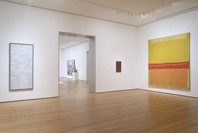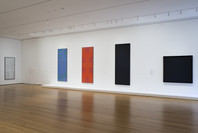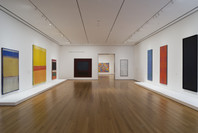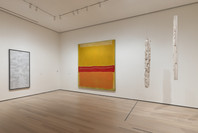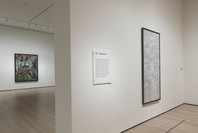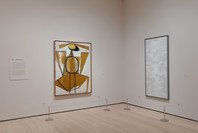This painting is one of several monochromes in which Reinhardt explored the use of a vertical format. The combination of the white paint with the natural color of the underlying canvas emphasizes the composition's tonal variations. The rough-edged, horizontal brushstrokes of varying length and paint saturation create a bricklike pattern that is at once structured and painterly. Reinhardt developed these brick forms with greater linearity and modularity in paintings such as Abstract Painting (Blue) of 1953.
Gallery label from Focus: Ad Reinhardt and Mark Rothko, 2008.
While his New York School peers Willem de Kooning and Jackson Pollock used gestural painting techniques, Reinhardt’s work of the 1950s deliberately lacks both the physically aggressive handling of paint and the hot emotion characteristic of these artists. This attitude may be seen in the increasing austerity of his paintings and in the restrained brushwork of Number 107. The painting is one of a number of monochromes he produced in the 1950s, for which he explored a vertical format. Working in white over an off-white ground, Reinhardt fosters subtle chromatic variations by adding solvent to his paint, alternating opaque with translucent passages, and creating a bricklike pattern of horizontal brushstrokes that is both structured and painterly.
Additional text from In The Studio: Postwar Abstract Painting online course, Coursera, 2017

